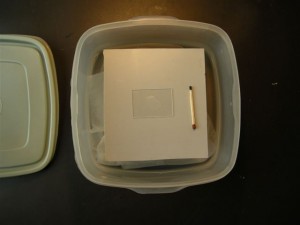A warning at the beginning.The following text will be a horror for normal daffodil freaks. It is for younger hybridizers only, perhaps up to an age of 80, because the results of the remarks in form of nice daffodils can be seen not until 6 or 10 years in the best case.
If a daffodil has two or four sets of homologous chromosomes it is in most cases fertile. If the two sets of a daffodil are different, as for example in the case of Hawera with one set of N. triandrus and one of N. jonquilla, you have nearly no chance for fertility. If there are two sets of homologous chromosomes and one different you have a low possibility . This case exists for crosses between tetraploid standard daffodils and most species. In DaffSeek you find in class 7 for Jonquilla Daffodils only few fertile plants of this type: Canary, Fruitcup, Mathinna, Trevithian, Bellsong Tittle Tattle, Cherie and Lanarth .For Triandrus Daffodils of these crosses are listed as fertile: Honey Bells, Lemon Drops, Harmony Bells, Silver Bells, Niveth, Ripling Waters, Robert Berkely and Thalia.Some of these daffodils have no registered descendants, most of them one or few. I think some more daffodils with this chromosome constitution should be fertile, but nobody looked at the pollen.
If you do this, you have three possibilities:
- The anthers look dry and you see no pollen. This means the flower is not fertile.
- Pollen mass is to be seen with the naked eye; under the mikroscope you find deformed or very little pollen corns or good looking pollen corns, which do not sprout .
- Pollen mass is to be seen. Under the mikroscope a good part of the pollen corns looks fine and some of them sproute, if treated in the right way.
The method of causing the pollen to sprout and examining it under a microscope has been described by Laurence Trevanion in ‘A Look at Pollen, The Daffodil Journal, Vol. 37, Nr.2, December 2000, pages 90-102’. He proposed a sugar solution as a medium for sprouting the pollen. In most cases this works well, but some pollen show no signs of life. I found out that these pollen may grow, if you enrich the sugar solution with an addition of the Murashige and Skoog Basal Salt Mixture, which is used for tissue culture and which you can get for example from ‘Sigma-Aldrich Fine Chemicals’. I dissolve 1,4 g of sugar and 20 mg of Murashige and Skoog medium in 20ml of deionizid water.These exact amounts are not really necessary. You can take an eggcup, fill it with deionized water and give to this a quarter of a teaspoon of sugar and a knifepoint of Murashige and Scoog Medium. A drop of the solution is given on a glass slide and pollen is moved on the point of a match from the anthers to the drop. The slide is kept at room temperature in a closed plastic box with water on the ground (see picture), to reduce evaporation from the drop. Two hours later you can see the sprouts with a microscope, if the pollen is fertile. The microscope you can buy at a low price in a shop for toys.
In this year I found four fertile daffodils from the following crosses in my seed beds, the number of sprouts within a drop is given in brackets: Altruist x N. cordubensis(8), Loch Leven x N. cordubensis(2), unknown standard daffodil x N. cordubensis(10), ((Pontresina x ( Edna Earl x Rashee)) x N. assoanus(30). The first question is: Which composition has the pollen, the second: Which crosses are interesting. It is not plausibel, that the plants should be tetraploid of the type NNJJ and the pollen of NJ. N is the chromosome set of the standard daffodil and J that of the Jonquilla. This case is seldom and the number of sprouting pollen corns would be greater. It is more probable that the plants are of the type NNJ, which is the normal case.Very seldom fails the reduction division during meiosis with pollen NNJ as the consequence. Furthermore the pollen can be N, which is not interesting for crosses or NJ, with little variations concerning the number of J- chromosomes per set. For the best case scenario ‘NJ’ exist many interesting possibilities for crossing.
- If the listed daffodils are seed fertile too with NJ egg cells, they can be crossed with each other. The products would be tetraploid daffodils of the form NNJJ like Hillstar, Limequilla , Quick Step and some others but with a greater spectrum for colours. The disadvantage is: If the seed fertility is as low as the fertility of the pollen, many flowers would be needed to get some seed corns.
- Successful should be the generation of fertile tetraploid daffodils by crosses with the existing sorts like Hillstar, Quickstep, Regeneration, Pink Step. Perhaps the children have red or pink cups. Similar crosses can be made for example with Emerald Sea (NNVV) and its relatives with two chromosome sets of standard daffodils and two sets of N.viridiflorus. The children are NNJV which should be fertile like NNJJ, because both V and J belong to the Jonquilla Group.
- All diploid species can be combined with NJ- pollen for example N. triandrus (TrTr), which gives NJTr like the new Crystal Bells, Euphonic Bells and Meticulous from Mitch Daffodils, which however come from Limequilla x N. triandrus. With three different chromosome sets they should have more vitality than JTr a cross of N. Jonquilla with N. triandrus. All these crosses are infertile.
- Matador (NNTT) with two chromosome sets of standard daffodils and two sets of N. tazetta gives with NJ-pollen NNJT descendants.

